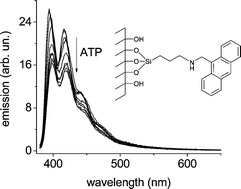Anthrylmethylamine functionalised mesoporous silica-based materials as hybrid fluorescent chemosensors for ATP
Abstract
A number of functionalised mesoporous solids containing anchored anthrylmethylamine groups have been prepared using different co-hydrolysis or grafting synthetic routes. The solids have been characterised using standard solid-state techniques. Solids with a low loading of the anthrylmethylamine probe show typical well defined and structured emission bands centred at ca. 415 nm. Addition of ATP to suspensions of these solids at pH 2.8 resulted in a quenching of the

- This article is part of the themed collection: Fluorescent sensors

 Please wait while we load your content...
Please wait while we load your content...